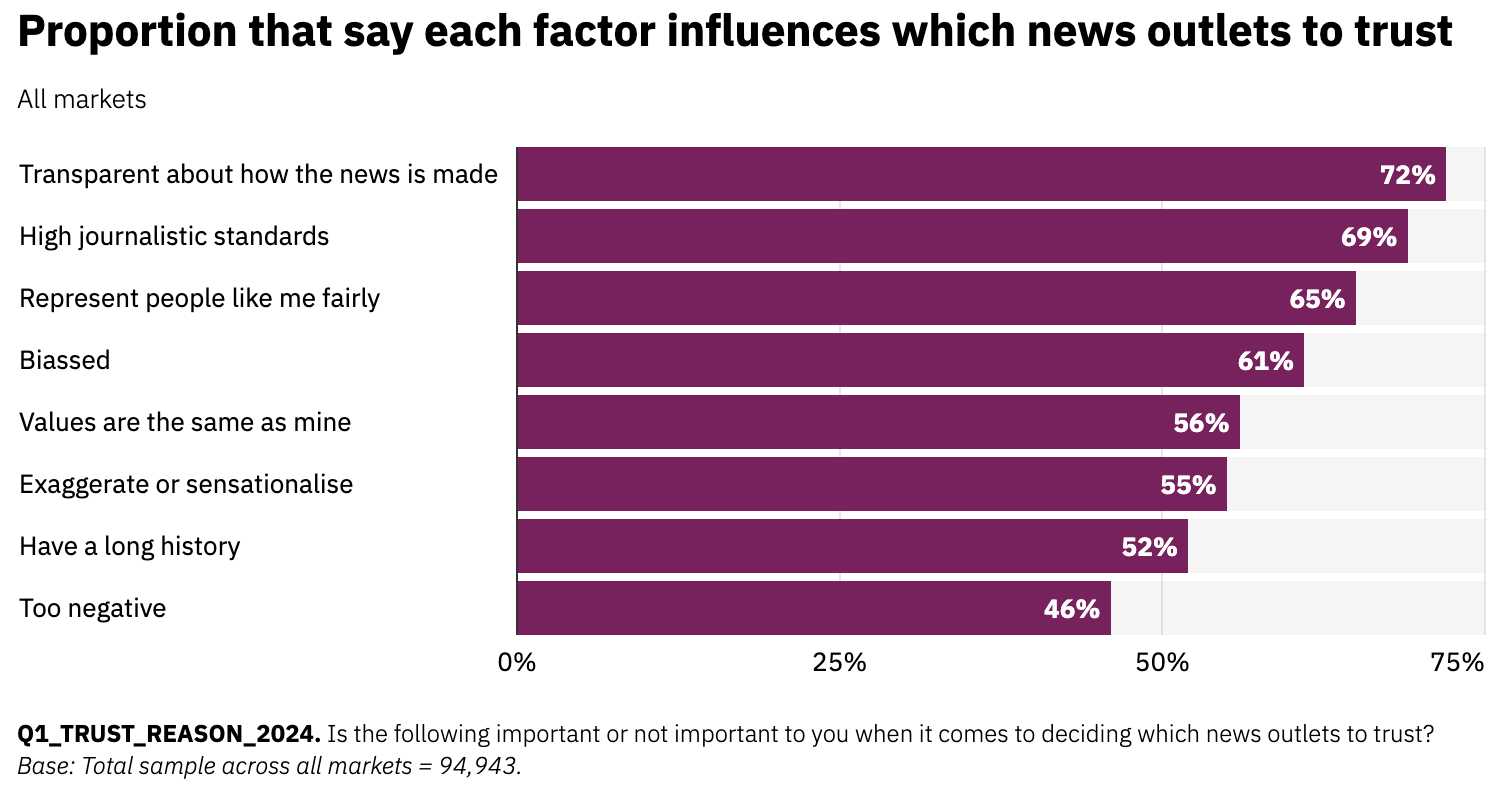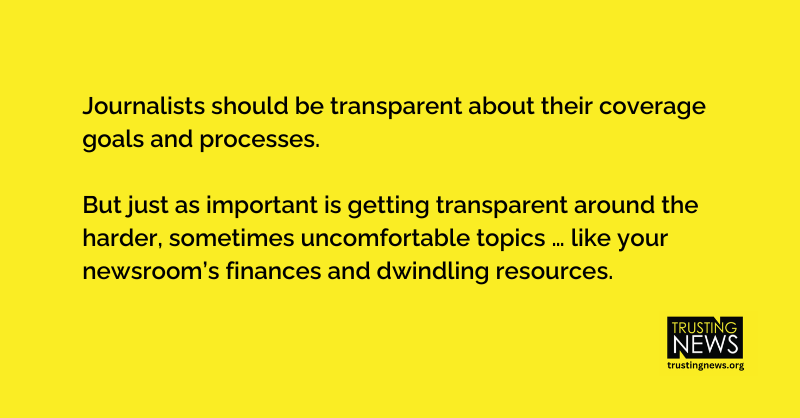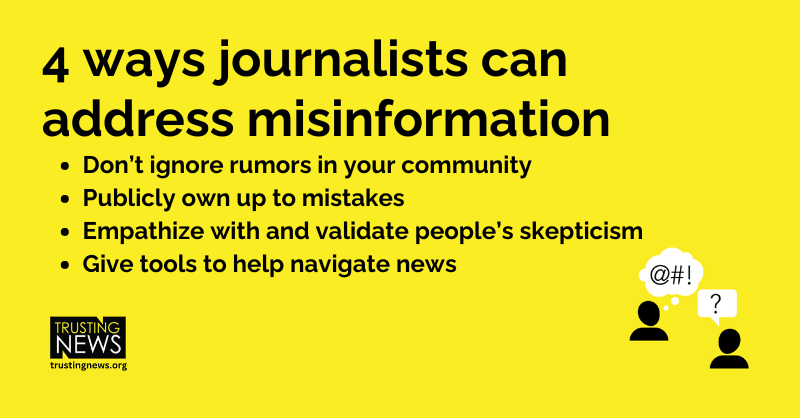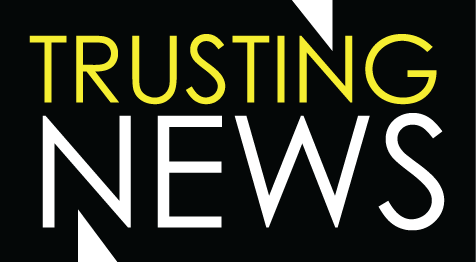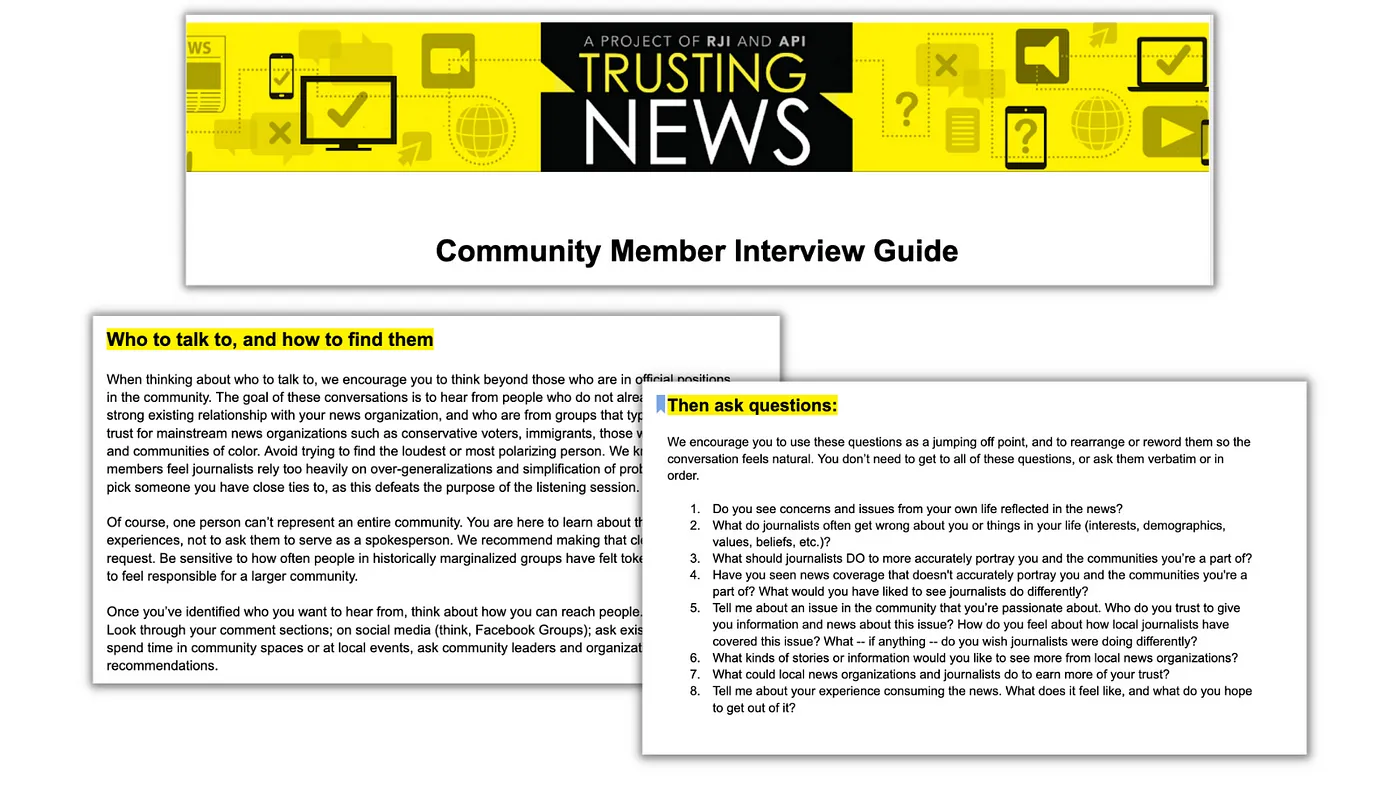
If you’re a journalist wanting to reach more diverse audiences, especially audiences that have been historically ignored or underserved by your newsroom, a lot of that work starts with laying a foundation of trust. Without understanding the assumptions that have led to distrust and the roadblocks that exist in creating sustained relationships, it’s almost impossible for […]
Step-by-step guide: How journalists can talk to people who don’t trust news (and build trust doing it)
If you’re a journalist wanting to reach more diverse audiences, especially audiences that have been historically ignored or underserved by your newsroom, a lot of that work starts with laying a foundation of trust.
Without understanding the assumptions that have led to distrust and the roadblocks that exist in creating sustained relationships, it’s almost impossible for journalists to be able to reach and serve these audiences.
That’s why our team and our research partners decided to work alongside nine journalists, helping guide them through listening and engaging authentically with audiences who don’t trust them. This research builds on work we’ve done with previous newsroom partners and classes.
With the use of an interview guide, these journalists sat down with people in their community who had low trust in news to learn about their assumptions and feelings about the news, and to look for themes they could bring back to their news organizations.
The summary of what we found: Taking the time to just listen to your community makes them more likely to trust you as a journalist and trust your organization.
Read more:
- We’ve updated our community interview guide that walks journalists through how to have conversations with people who have low trust in news.
- We wrote more here about how the research was done and what recommendations came from the analysis.
- Read what our partner journalists learned about reaching new audiences and building sustainable relationships.
This post is a step-by-step guide to identifying audiences you’re missing, finding people to talk to, hosting a (non-defensive) conversation, and acting on what you learn.
A big thanks to our newsroom partners and the researchers who helped us with this project. The following learnings wouldn’t have been possible without them!
First: Identity who it is you’re trying to reach
Who you’re trying to reach will vary from newsroom to newsroom, but we recommend you try to hear people who don’t trust your news organization and/or don’t already have a strong existing relationship with you. Some of the newsrooms in our project were trying to reach more conservative audiences. Some were trying to hear from younger audiences, immigrants, or communities of color.
If you’re not already in tune with what communities don’t trust your news, start by taking stock of what voices tend to be missing in your coverage. What’s the makeup of your subscriber, listener, viewer or reader base? If you host newsroom events, what groups of people don’t show up? Are there people who tend to leave negative comments, or share feedback that they don’t feel accurately reflected in your coverage?
For most news organizations, there will be multiple groups that have low trust in news. But for this project to be useful, we recommend you start by getting specific — focusing on a certain location, community, or group of people. That will help you narrow your search and make your findings more useful.
It can be challenging to get started. The whole purpose of these interactions is to hear from people who aren’t already connected to your news organization, whether a subscriber or source, and those might be people who are not big fans of your work. This means they will be more challenging to reach, and possibly more challenging to have a conversation with. Go into the project knowing that might take some investment.
Second: Find people to talk to
Once you’ve identified what groups and communities you’d like insights from, think about where you’ll bump up against those people — at community events or community spaces. That could be libraries, local bars, farmers’ markets, neighborhood listservs, and pick-up soccer games.
Think about how you can utilize online groups, like Nextdoor, Reddit, or Facebook Groups. (We recommend you connect with a moderator in those spaces, explain what you’re trying to do, and ask if they’re willing to help.) Also, look at your organization’s own feedback loops, like emails and comment sections, and see who is sharing their dissatisfaction. Journalists in the project also found success partnering with non-political community leaders for access to groups that have not typically been part of your base. So that might be a non-profit, a community group, or other organizations like the American Legion or a specific Chamber of Commerce.
You can also go to existing sources who you maybe have relationships with, and ask them to help put you in contact with people. They might have good insights into different communities and could help vouch for you and/or your news organization.
We do recommend you don’t just talk to those in official positions in the community. We know community members feel journalists rely too heavily on over-generalizations and simplification of problems, so try and go beyond just talking to people who are in official positions of power in the community, or who are the loudest or most polarizing figures in a community.
And, of course, one person can’t represent an entire community. You are here to learn about this person’s experiences, not to ask them to serve as a spokesperson. We recommend making that clear in your request. Be sensitive to how often people in historically marginalized groups have felt tokenized or made to feel responsible for a larger community.
Also, we want to acknowledge that you’re not trying to win over every person who is skeptical of or hostile toward journalism. If someone seems unreachable and isn’t won over by facts, they likely will never be part of the audience you reach, and that’s OK. We’re not here to reach everyone.
Third: Host a conversation driven by curiosity
Once you find people willing to engage with you, set up the conversation by explaining who you are and what it is you’re doing. If this is tied into a larger newsroom project or effort, mention that. Be sure to explain that nothing they say will be used in quotes in a story, and will only be shared internally in the newsroom to help your organization better itself.
We have a list of suggested questions to ask here. Go through and ask whatever questions feel relevant, skipping or rearranging the list in whatever way feels natural in the conversation.
As you enter the conversation, we encourage you (when appropriate) to acknowledge any place or privilege and position of power you hold (like even just being the journalist who is hosting the conversation.) Posture yourself in humility, acknowledging that your news organization may have ignored or caused harm to different communities in the past, but that you’re striving to do better and want to understand the issues facing them.
Remember that this is not a debate and that your goal in this conversation is to listen and learn. If the interviewee says things about journalism, or about your work specifically, that you’d like to correct or defend against, try to save those points for the end. We do hope that the subjects’ interactions with you help them understand and relate to journalists, and it’s OK to explain your credibility and best practices. But the primary goal of the conversation is to listen and understand, not bring them to your side, and not to win an argument. If you notice yourself feeling defensive, that’s normal! But keep your eyes on your goals. Think of this as an opportunity to hold your newsroom accountable for issues you may not have considered.
Also, from the interviews our partner journalists had, we know people often use somewhat vague terms like “the media”, “objectivity,” “bias” or “agenda” when talking about how they perceive the news. When these words come up, ask them for specifics — not in an effort to defend their point, but so you can better understand what they mean by the term.
Tip: When wrapping up the conversation, be sure to thank them for their time, and ask them if they have any friends or colleagues they think would have valuable insights to share with you.
Four: Follow up, and use your learnings
We recommend even if you thanked the community member in person, to send a note afterward thanking them again for their time. If you can, share an observation about what you learned, what you’ll share with your colleagues or what you will keep in mind in your own work as a result of the conversation.
Also, we highly encourage you to consistently track the answers to these questions, especially if you’re doing this project with others in the newsroom. Logging some notes about their responses, themes you saw, general impressions and findings is key to spotting themes and eventually taking action. And we’re human, so the sooner you can log the answers, the more nuance you’ll be able to remember about the interaction.
As you start to have more and more conversations, start looking through your notes and identify any themes you see come up.
If you can, try and have a few people in your newsroom do these outreach efforts on a somewhat consistent basis (one interview a month per journalist.) We shared more about this here, but consistency is key when it comes to building new audiences: Don’t just touch base this one time, and never talk to those people again, or ignore the feedback they give. It’s OK if you can’t act on everything, or make immediate changes, but we heard repeatedly from community members the importance of keeping a consistent presence in the communities you’re trying to reach.
If you have questions, feedback, or need help, feel free to reach out to our team via email or on Twitter.
We’re continuing on this Road to Pluralism
We’re excited to continue learning alongside newsrooms, helping journalists better understand audience perceptions and how people might feel about their coverage. Read more about the work we want to help newsrooms while on the Road to Pluralism.
Interested in learning more about this work or partnering with us in future pluralism work? Fill out this form. We’ll keep in touch as we have new projects and research opportunities.
One of the best ways to follow our work and see examples from other newsrooms is to subscribe to our weekly Trust Tips newsletter. If you have questions, feedback, or other thoughts, you can email us at info@trustingnews.org or reach out on Twitter.
At Trusting News, we learn how people decide what news to trust and turn that knowledge into actionable strategies for journalists. We train and empower journalists to take responsibility for demonstrating credibility and actively earning trust through transparency and engagement. Learn more about our work, vision and team. Subscribe to our Trust Tips newsletter. Follow us on Twitter and LinkedIn.
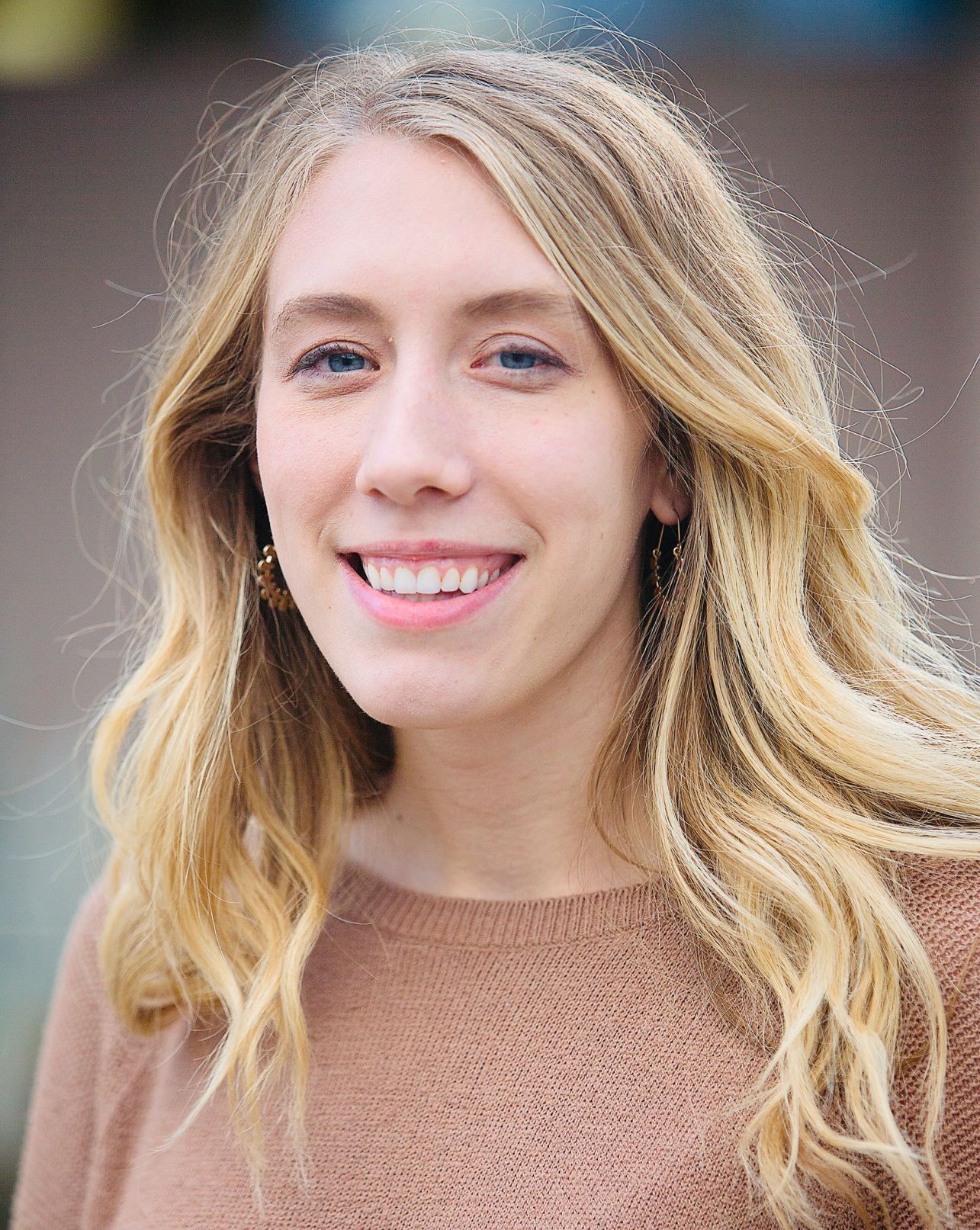
Project manager Mollie Muchna (she/her) has spent the last 10 years working in audience and engagement journalism in local newsrooms across the Southwest. She lives in Tucson, Arizona, where she is also an adjunct professor at the University of Arizona’s School of Journalism. She can be reached at mollie@trustingnews.org and on Twitter @molliemuchna.

